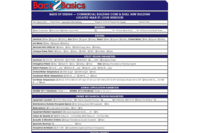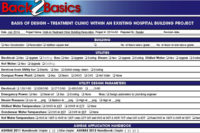The majority of, if not all, office buildings will go through a series of office space retrofits over the course of time. For those commercial building owners who lease space within their building(s) should have tenant space retrofit standards to compliment the regular building renovations within their facility. With each new tenant comes a Building Program (BP) document that will be the cornerstone for investing in an HVAC design and eventual construction of the HVAC systems to meet the building owner and tenant’s BP requirements.
For the HVAC engineer, she will take the BP information and craft a Basis of Design (BofD) using the suggested BofD template here. For this month’s test, we have documented the BP for a tenant fit-out in Washington.
On page 2 of this B2B, the reader shall complete the BofD by checking the correct boxes from the multiple choice selections based on the BP information provided on this page and from pertinent reference documents, such as local weather data design criteria for the Washington area. The answers to the BofD can be found here.
The tenant space retrofit is for 10,000 sq ft on the second floor of this three-story building with no basement. The project shall utilize capped existing supply and return air branch ducts above the ceiling but will not connect to the available existing exhaust duct. There will be no integration of the building’s engineered smoke control system that serves the core public space (front lobby entrance, three elevators in this second floor lobby). Utilities/services will be provided by the local electric and gas companies and the city water department via the building’s infrastructure.
The HVAC electrical requirements shall be 120/1/60 for motors less than .5 hp and 480/3/60 for motors .5 hp and larger. The gas service serves the existing high-efficiency condensing boilers that provide a closed loop hot water heating system to the core/common area, where branch runouts are valve and capped for connection to new tenant space terminals (VAV terminals, fan-powered terminals with heating coils, and 2-pipe fan coil units) as needed. There is chilled water supply and return piping distributed throughout the building, with valve and capped to this same equipment. Both the hot water and chilled water distribution shall be valve and capped runouts, but no chilled water is needed for this project. The tenant space requires a minimum of five VAV terminals, two fan-powered terminals with hot water heating coils, and no fan coil units. The existing building central air systems provide outdoor air ventilation, and the unit utilizes MERV 8 pre-filters and MERV 14 final filters. The air terminals shall be serviced in the occupied space. There is no requirement for standby capacity and no system/equipment spare capacity for the existing building infrastructure. A sound consultant shall be responsible for the acoustical design criteria for the tenant fitout.
The HVAC design of this new building construction shall be based on state and local codes and also the building tenant fitout standards. In addition, the design engineer should refer to the ASHRAE 2011 Application Handbook chapter 3, Commercial and Public Buildings, for basis of design requirements. The design engineer will draw upon other ASHRAE Standards and Guidelines for more design considerations.
When beginning to shape the BofD, the engineer should take into account the ASHRAE recommended chapter 2, Decentralized Cooling and Heating; chapter 4, Air Handling and Distribution; and Chapter 5, In-Room Distribution Systems, to design the optimum HVAC systems for this BP.
The design engineer, in conjunction with the building owner and the architect, has finalized the HVAC system to include uses of the valve and capped hot water heating system along with capped supply and return air duct distribution. There will be no tenant space energy meters.
The tenant space HVAC systems shall be designed for occupied-unoccupied modes of operation with morning warm-up and cool-down at the perimeter spaces as part of the sequence of tenant space of operation. The building’s hot water heating system is an outdoor temperature compensated system (160?F HWS & 120?F HWR at 17?F outdoors, and 105?F HWS & 85?F HWR at 60?F with the boilers off when greater than 60?F outdoors). Occupied space shall be maintained at 70?F with no humidity control in the heating season and 76?F and a not-to-exceed 60% relative humidity during the air conditioning season. Equipment room and back-of-the-room support areas are existing and not part of this tenant retrofit project.
The tenant space will not have a LEED certification. The reader is directed to the Facility Files for the Owner’s Building Program Annual Operating Budget and Operating Program, where the building owner will outsource the entire O&M of the facility and will include those services to the tenant space.
As the design phase for this BP goes forward, the BofD should be routinely referenced and updated based on changes in the BP, as well as upon changes and/or enhancements to the HVAC design.







